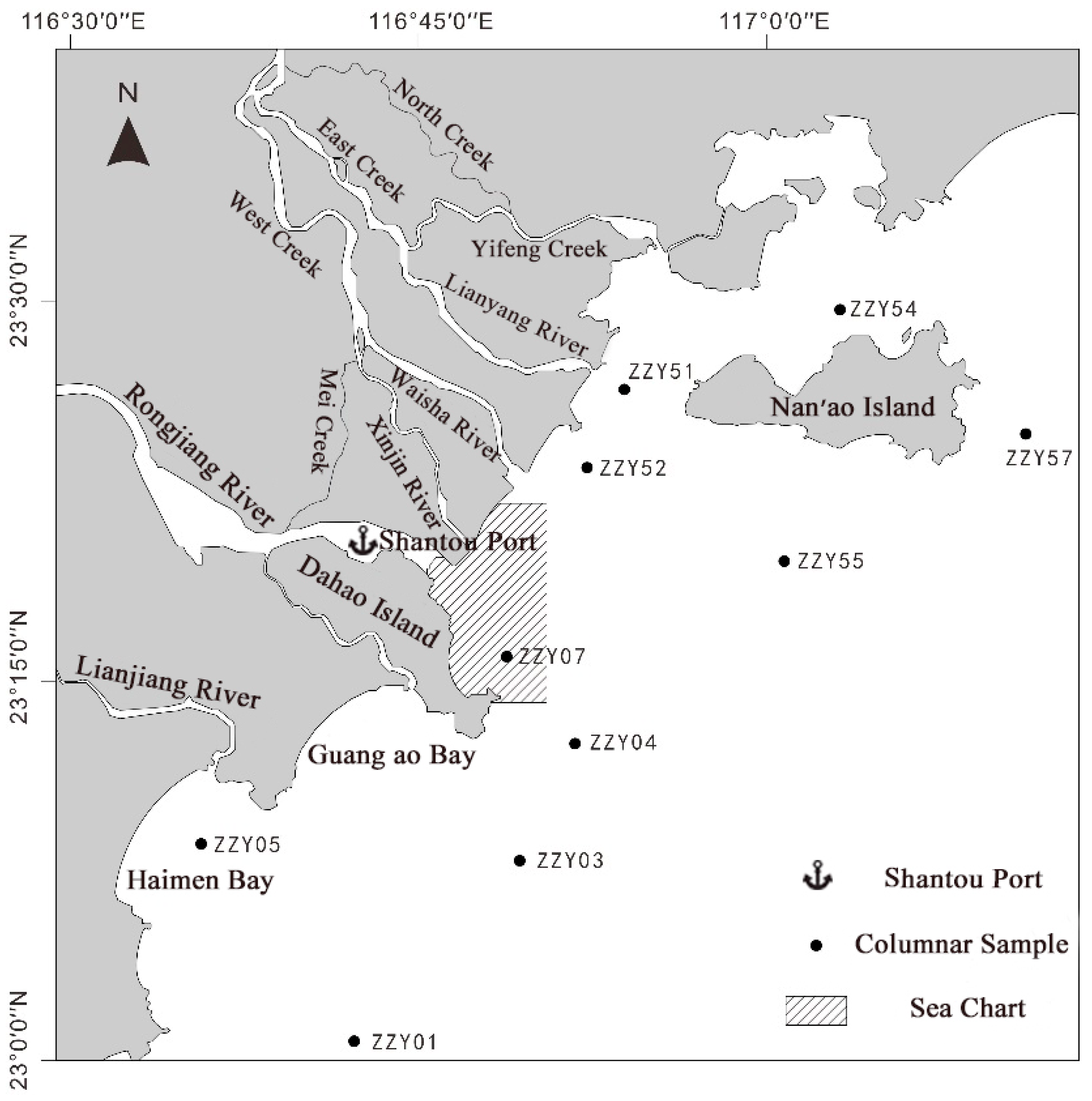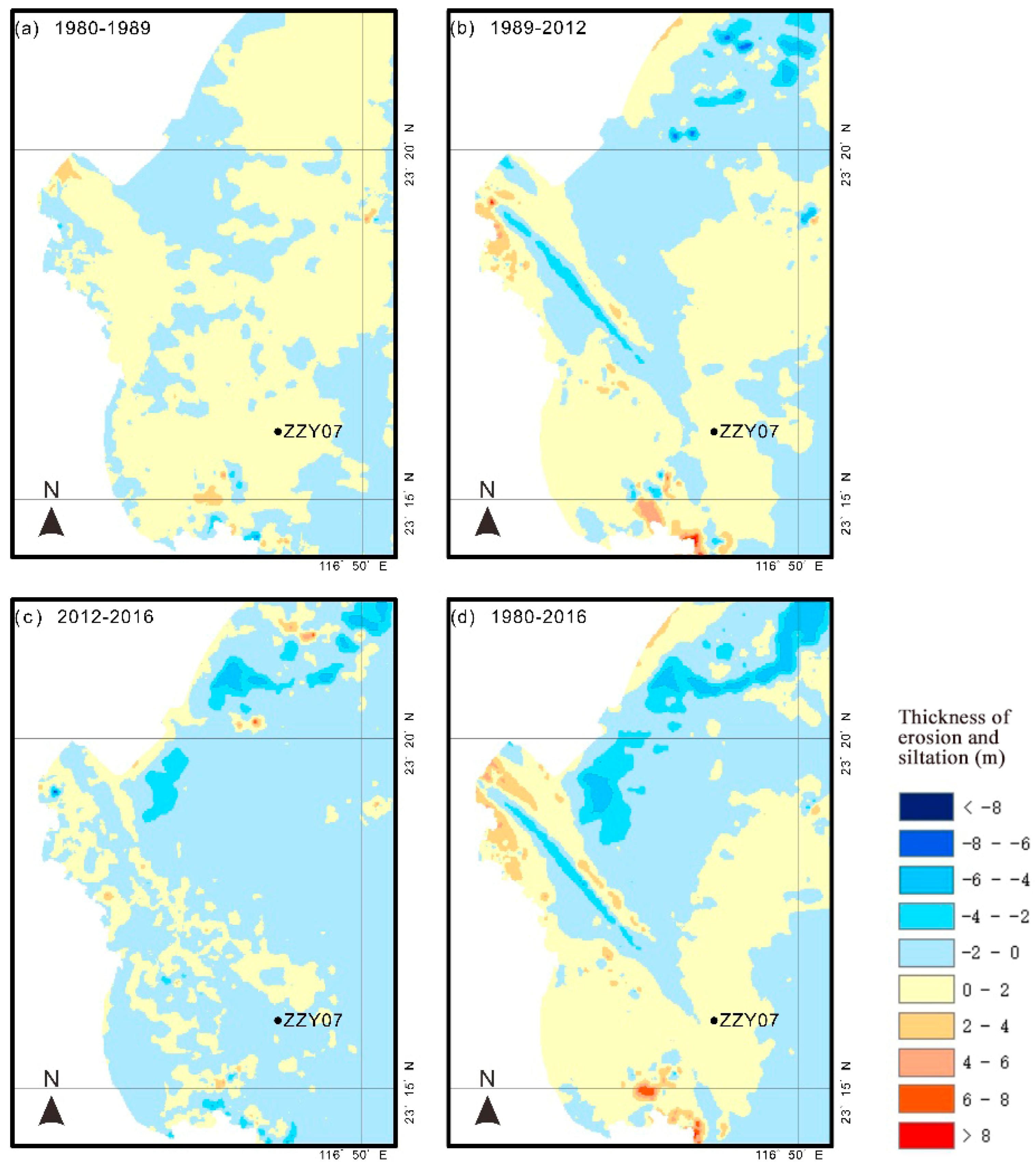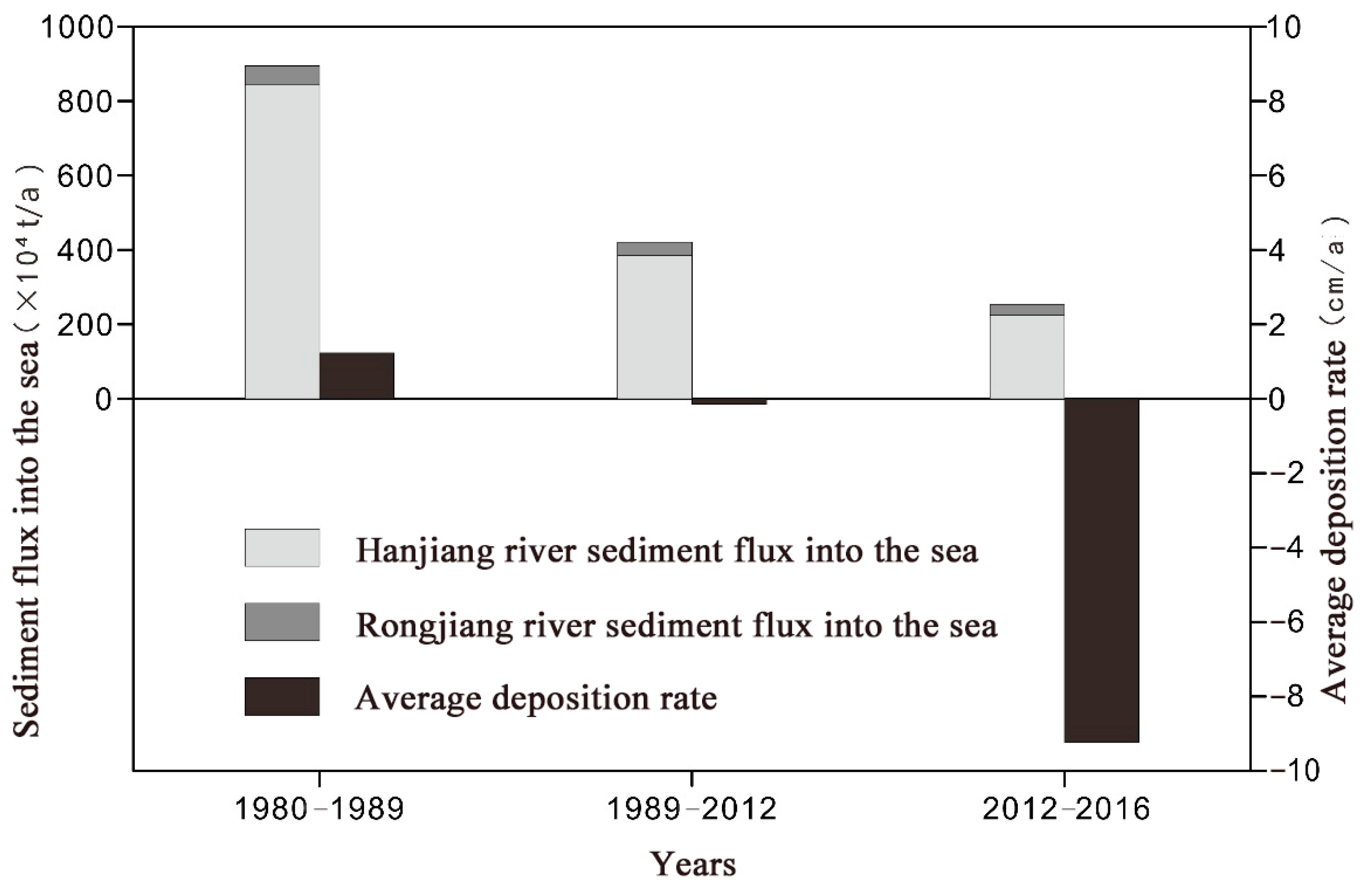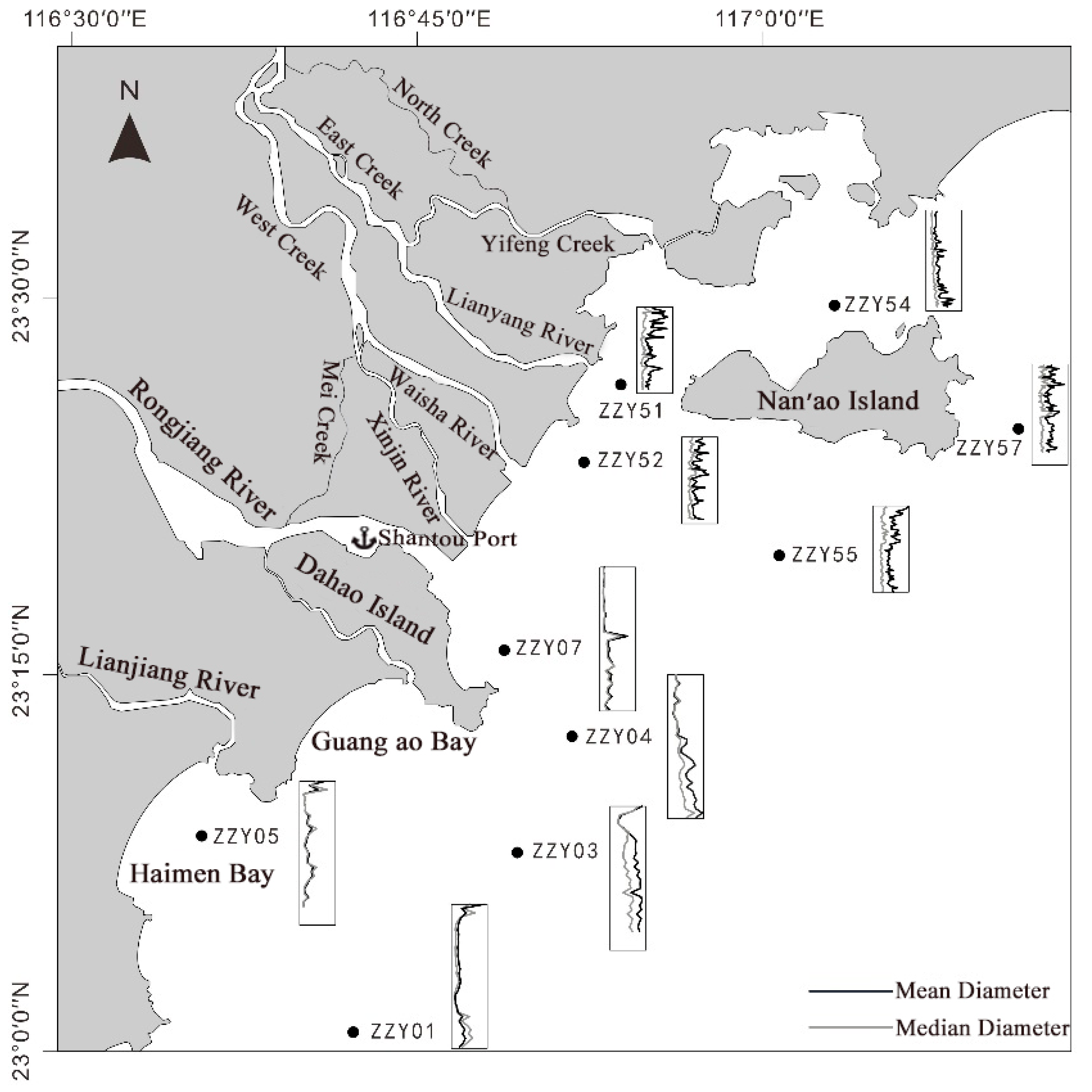Influence of the Hanjiang River’s Inlet Sediment Decrease on Modern Sedimentation in the Underwater Delta
Abstract
1. Introduction
2. Materials and Methods
2.1. Research Materials
2.2. Research Methods
2.2.1. Calculation of the Erosion and Deposition Evolution of the Underwater Delta
2.2.2. 210Pb Dating of Columnar Samples
2.2.3. Particle Size Analysis
3. Results
3.1. Underwater Delta Erosion and Deposition Evolution
3.2. 210Pb Dating Results for Columnar Samples
3.3. Particle Size Analysis
4. Discussion
4.1. Effect of the Sediment Flux of the Hanjiang River on Erosion and Deposition in the Subaqueous Delta
4.2. The Effect of the Sharp Decrease in the Sediment Flux from the Hanjiang River into the Sea on the Deposition Rate
4.3. The Effect of the Sharp Decrease in the Sediment Flux from the Hanjiang River into the Sea on the Sediment Particle Size
5. Conclusions
- (1)
- The significant reduction in sediment fluxes from the Hanjiang and Rongjiang Rivers into the sea led to the transformation of the underwater delta area in the outer channel of Shantou Port from a depositional state in 1980–1989 to an erosional state in 1989–2016, which was positively correlated with the significant reduction in the sediment fluxes from the Hanjiang and Rongjiang Rivers into the sea.
- (2)
- The significant reduction in the sediment flux into the sea from the Hanjiang River generally reduced the deposition rate of the underwater delta. In the area close to the estuary, the change in the deposition rate of the columnar samples (ZZY51, ZZY55, and ZZY04) is more distinct than that far from the estuary (ZZY01).
- (3)
- The significant reduction in the sediment flux into the sea from the Hanjiang River led to a transformation from deposition to erosion of the underwater delta area near the estuary.
Author Contributions
Funding
Acknowledgments
Conflicts of Interest
References
- Vörösmarty, C.J.; Meybeck, M.; Fekete, B.; Sharma, K.; Green, P.; Syvitski, J.P. Anthropogenic sediment retention: Major global impact from registered river impoundments. Glob. Planet. Chang. 2003, 39, 169–190. [Google Scholar] [CrossRef]
- Syvitski, J.P.M.; Vörösmarty, C.J.; Kettner, A.J.; Green, P. Impact of humans on the flux of terrestrial sediment to the global coastal ocean. Science 2005, 308, 376–380. [Google Scholar] [CrossRef]
- Walling, D.E. Human impact on land-ocean sediment transfer by the world’s rivers. Geomorphology 2006, 79, 192–216. [Google Scholar] [CrossRef]
- Liu, F.; Chen, S.; Dong, P.; Peng, J. Spatial and temporal variability of water discharge in the Yellow River Basin over the past 60 years. J. Geogr. Sci. 2012, 22, 1013–1033. [Google Scholar] [CrossRef]
- Welch, A.C.; Nicholls, R.J.; Lázár, A.N. Evolving deltas: Coevolution with engineered interventions. Elem. Sci. Anthr. 2017, 5, 49. [Google Scholar] [CrossRef]
- Jiang, C.; Chen, S.; Pan, S.; Fan, Y.; Ji, H. Geomorphic evolution of the Yellow River Delta: Quantifications of basin-scale natural and anthropogenic impacts. Catena 2018, 163, 361–377. [Google Scholar] [CrossRef]
- Kondolf, G.M.; Schmitt, R.J.P.; Carling, P.; Darby, S.; Arias, M.E.; Bizzi, S.; Castelletti, A.; Cochrane, T.A.; Gibson, S.; Kummu, M.; et al. Changing sediment budget of the Mekong: Cumulative threats and management strategies for a large river basin. Sci. Total Environ. 2018, 625, 114–134. [Google Scholar] [CrossRef]
- Dunn, F.E.; Darby, S.E.; Nicholls, R.J.; Cohen, S.; Zarfl, C.; Fekete, B.M. Projections of declining fluvial sediment delivery to major deltas worldwide in response to climate change and anthropogenic stress. Environ. Res. Lett. 2019, 14, 084034. [Google Scholar] [CrossRef]
- Nienhuis, J.H.; Ashton, A.D.; Edmonds, D.A.; Hoitink, A.J.F.; Kettner, A.J.; Rowland, J.C.; Törnqvist, T.E. Global-scale human impact on delta morphology has led to net land area gain. Nature 2020, 577, 514–518. [Google Scholar] [CrossRef]
- Ericson, J.P.; Vörösmarty, C.J.; Dingman, S.L.; Ward, L.G.; Meybeck, M. Effective sea-level rise and deltas: Causes of change and human dimension implications. Glob. Planet. Chang. 2006, 50, 63–82. [Google Scholar] [CrossRef]
- Gao, J.H.; Shi, Y.; Sheng, H.; Kettner, A.J.; Yang, Y.; Jia, J.J.; Wang, Y.P.; Li, J.; Chen, Y.; Zou, X.; et al. Rapid response of the Changjiang (Yangtze) River and East China Sea source-to-sink conveying system to human induced catchment perturbations. Mar. Geol. 2019, 414, 1–17. [Google Scholar] [CrossRef]
- Yang, C.X.; Zhang, Z.D.; Zhang, Q.; Dong, C.; Wan, L. Characteristics of Multi—Scale Variability of Water Discharge and Sediment Load in the Hanjiang River During 1955–2012. J. South China Norm. Univ. (Nat. Sci. Ed.) 2017, 49, 68–75. [Google Scholar]
- Zhao, L. Characteristic Analysis of Runoff and Sediment at Chao’an Hydrometric Station in Hanjiang River Basin. Guangdong Water Resour. Hydropower 2019, 4, 22–25. [Google Scholar]
- Zhang, Y.P. Analysis of sediment variation in Chao’an Station of Hanjiang River. Sci. Technol. Innov. 2016, 15, 78–80. [Google Scholar]
- Wang, Y.F.; Liu, X.J.; Wang, Y.; Wang, W.; Wang, H.; Yi, J. Changes in Sediment Flux from Hanjiang River into the Sea and Its Influence on Adjacent Sea Areas over the Last 60 Years. Pearl River 2022, 43, 7. [Google Scholar]
- Zhang, J.H.; He, Q.; Han, X. Analysis of seabed evolution in southeast Guangdong sea area. China Water Transp. 2020, 20, 146–148. [Google Scholar]
- Maloney, J.M.; Bentley, S.J.; Xu, K.; Obelcz, J.; Georgiou, I.Y.; Miner, M.D. Mississippi River subaqueous delta is entering a stage of retrogradation. Mar. Geol. 2018, 400, 12–23. [Google Scholar] [CrossRef]
- Yang, S.L.; Milliman, J.D.; Li, P.; Xu, K. 50000 dams later: Erosion of the Yangtze River and its delta. Glob. Planet. Chang. 2011, 75, 14–20. [Google Scholar] [CrossRef]
- Ji, H.Y. Morphological Variability of the Yellow River Delta and Its Dynamic Mechanism under the New Regime of River Delivery; East China Normal University: Shanghai, China, 2021. [Google Scholar]
- Yang, L.Z.; Liu, F.; Gong, W.P.; Cai, H.; Yu, F.; Pan, H. Morphological response of Lingding Bay in the Pearl River Estuary to human intervention in recent decades. Ocean. Coast. Manag. 2019, 176, 1–10. [Google Scholar] [CrossRef]
- Wang, A.J.; Ye, X.; Lin, Z.K.; Wang, L.; Lin, J. Response of sedimentation processes in the Minjiang River subaqueous delta to anthropogenic activities in the river basin. Estuar. Coast. Shelf Sci. 2020, 232, 106484. [Google Scholar]
- Yang, H.F.; Yang, S.L.; Meng, Y.; Xu, K.; Luo, X.; Wu, C.; Shi, B. Recent coarsening of sediments on the southern Yangtze subaqueous delta front: A response to river damming. Cont. Shelf Res. 2018, 155, 45–51. [Google Scholar] [CrossRef]
- Liu, L.; Wang, H.J.; Yang, Z.S.; Fan, Y.; Wu, X.; Hu, L.; Bi, N. Coarsening of sediments from the Huanghe (Yellow River) delta-coast and its environmental implications. Geomorphology 2022, 401, 108105. [Google Scholar] [CrossRef]
- Zhan, Q.; Li, M.T.; Liu, X.Q.; Chen, J.; Chen, Z. Sedimentary transition of the Yangtze subaqueous delta during the past century: Inspiration for delta response to future decline of sediment supply. Mar. Geol. 2020, 428, 106279. [Google Scholar] [CrossRef]
- Liu, J.P.; Xu, K.H.; Li, A.C.; Milliman, J.; Velozzi, D.; Xiao, S.; Yang, Z. Flux and fate of Yangtze River sediment delivered to the East China Sea. Geomorphology 2007, 85, 208–224. [Google Scholar] [CrossRef]
- Zheng, S.; Han, S.S.; Tan, G.M.; Xia, J.; Wu, B.; Wang, K.; Edmonds, D.A. Morphological adjustment of the Qingshuigou channel on the Yellow River Delta and factors controlling its avulsion. Catena 2018, 166, 44–55. [Google Scholar] [CrossRef]
- Wu, X.; Bi, N.S.; Xu, J.P.; Nittrouer, J.A.; Yang, Z.; Saito, Y.; Wang, H. Stepwise morphological evolution of the active Yellow River (Huanghe) delta lobe (1976–2013): Dominant roles of riverine discharge and sediment grain size. Geomorphology 2017, 292, 115–127. [Google Scholar] [CrossRef]
- Li, G.X.; Zhuang, K.L.; Wei, H.L. Sedimentation in the Yellow River delta. Part III. Seabed erosion and diapirism in the abandoned subaqueous delta lobe. Mar. Geol. 2000, 168, 129–144. [Google Scholar] [CrossRef]









| Serial Number | Sheet Number | Year of Publication | Year of Measurement | Name of Chart | Scale | Number of Water Depth Points | Measuring Unit |
|---|---|---|---|---|---|---|---|
| 1 | 15,112 | 1984 | 1979 and 1980 1971 and 1966 | Shantou Port | 1:15,000 | 1583 | Chinese People‘s Liberation Army Naval Command Navigation Guarantee Department |
| 2 | 15,112 | 1993 | 1989 and 1966 | Shantou Port | 1:15,000 | 1784 | |
| 3 | 15,113 | 2013 | 2012 and 2013 | Shantou Port Outer Channel | 1:15,000 | 1692 | |
| 4 | 15,113 | 2018 | 2016 and 2017 | Shantou Port Outer Channel | 1:15,000 | 2349 | Chinese People‘s Liberation Army Naval Command Navigation Guarantee Department |
| 1980–2016 | 1980–1989 | 1989–2012 | 2012–2016 | |
|---|---|---|---|---|
| Period length (a) | 36 | 9 | 23 | 4 |
| Total area (107 m2) | 11.14 | 11.22 | 11.22 | 11.19 |
| Sedimentation area (107 m2) | 5.10 | 7.40 | 5.83 | 2.04 |
| Sedimentation volume (107 m3) | 3.44 | 2.18 | 3.24 | 0.79 |
| Sedimentation thickness (m) | 0.68 | 0.29 | 0.55 | 0.39 |
| Erosion area (107 m2) | 6.04 | 3.81 | 5.38 | 9.15 |
| Erosion volume (107 m3) | 6.29 | 0.94 | 3.63 | 4.93 |
| Erosion thickness (m) | 1.04 | 0.25 | 0.67 | 0.54 |
| Net erosion volume (107 m3) | −2.84 | 1.24 | −0.40 | −4.14 |
| Net deposition thickness (m) | −0.26 | 0.11 | −0.04 | −0.37 |
| Average net erosion and deposition volume of the period (107 m3/a) | −0.08 | 0.14 | −0.02 | −1.03 |
| Average deposition rate over time (cm/a) | −0.71 | 1.23 | −0.15 | −9.24 |
| Period | 1980–1989 | 1989–2012 | 2012–2016 | |
|---|---|---|---|---|
| Average annual sediment flux into the sea (10,000 t) | Han Jiang | 843.1 | 384.4 | 225.7 |
| Rongjiang | 51.5 (1980–1987) | 36.3 (2006–2012) | 26.9 | |
| Shantou Port Outer Channel | Silt thickness (m) | 0.11 | −0.04 | −0.37 |
| Average deposition rate (cm/a) | 1.23 | −0.15 | −9.24 | |
| ZZY07 | Silt thickness (m) | 0.38 | 0.31 | −0.11 |
| Average deposition rate (cm/a) | 4.22 | 1.36 | −2.75 | |
| ZZY51 | ZZY55 | ZZY04 | ZZY01 | ZZY07 (The Deposition Rate Comes from the Chart) | |
|---|---|---|---|---|---|
| Average deposition rate of the whole section (cm/a) | 0.84 | 1.54 | 1.25 | 2.31 | 1.92 |
| Average deposition rate of the upper section (cm/a) | 0.57 | 0.76 | 0.50 | 1.90 | −2.75 (2012–2016) 1.36 (1989–2012) 4.22 (2012–2016) |
| Depth range (cm) | 0–42 | 0–62 | 0–84 | 0–96 | 0–31 (2016–1989) 31–69 (1980–1989) |
| Deposition rate reduction (%) | 32.1 | 50.6 | 60.0 | 17.7 | 67.8 (1989–2012 compared to 1980–1989) |
| Column Number | Sand Content (%) | Silt Content (%) | Clay Content (%) | Average Particle Size Average (μm) | Median Particle Size Mean (μm) | Sorting Factor | Skewness | Kurtosis |
|---|---|---|---|---|---|---|---|---|
| ZZY51 | 2.8–22.6 | 55.5–72.8 | 16.8–36.8 | 25.0 | 10.9 | 2.0–3.9 | 1.7–4.3 | 2.4–23.3 |
| ZZY52 | 0.0–1.9 | 57.5–73.0 | 25.2–42.4 | 13.0 | 7.6 | 1.9–2.4 | 1.5–3.7 | 1.6–17.3 |
| ZZY55 | 2.9–19.0 | 60.7–72.7 | 19.0–30.2 | 22.3 | 10.9 | 1.9–2.9 | 1.7–5.1 | 2.7–33.7 |
| ZZY03 | 10.3–41.4 | 53.4–75.1 | 2.6–26.7 | 27.9 | 19.5 | 2.0–2.7 | −0.5–0.1 | 0.6–1.3 |
| ZZY07 | 9.0–49.6 | 45.9–82.2 | 4.4–33.7 | 16.9 | 15.0 | 1.4–2.9 | −0.3–0.4 | 0.7–1.2 |
| ZZY54 | 1.3–14.3 | 61.1–76.5 | 18.1–24.6 | 14.6 | 8.5 | 1.8–2.7 | 0.5–3.7 | −1.4–18.9 |
| ZZY04 | 2.2–43.9 | 53.3–76.6 | 2.8–30.5 | 18.7 | 13.6 | 1.8–2.5 | −0.5–0.2 | 0.6–1.4 |
| ZZY01 | 20.3–65.2 | 30.2–73.0 | 3.0–21.2 | 37.3 | 36 | 2.1–2.7 | −0.4–0.5 | 0.6–1.2 |
| ZZY05 | 4.4–50.1 | 43.9–82.7 | 5.3–26.7 | 19.5 | 19.9 | 1.2–2.3 | −0.3–0.5 | 0.7–1.4 |
| ZZY57 | 0.1–14.4 | 65.3–76.2 | 14.8–34.6 | 21.1 | 12.0 | 2.0–2.7 | 1.5–2.8 | 1.7–8.9 |
| Column Number | Grain Size Change Boundary Position Depth (cm) | Below the Boundary Depth | Above the Boundary Depth | ||
|---|---|---|---|---|---|
| Average Particle Size (μm) | Mean Value of Median Particle Size (μm) | Average Particle Size (μm) | Mean Value of Median Particle Size (μm) | ||
| ZZY51 | 0–42 | 20.7 | 10.0 | 33.2 | 12.5 |
| ZZY52 | 0–58 | 11.3 | 6.7 | 14.7 | 8.5 |
| ZZY55 | 0–54 | 19.1 | 9.9 | 26.4 | 12.3 |
| ZZY03 | 0–42 | 30.8 | 20.2 | 18.2 | 17.2 |
| ZZY07 | 0–96 | 23.5 | 20.2 | 9.5 | 9.1 |
| ZZY54 | 0–124 | 24.7 | 12.2 | 13.4 | 8.0 |
| Erosion and Deposition Situation in Different Stages | Mississippi River Underwater Delta | Yangtze River Underwater Delta | Yellow River Underwater Delta | Pearl River Lingdingyang Estuary West Beach |
|---|---|---|---|---|
| Rapid deposition stage | 317 ± 54 Mt/a (1874–1940) | 6.8 cm/a (1958–1977) | 0.93 × 108 m3/a (2002–2007) | 3.63 × 106 m3 (1978–1985) |
| Decreased deposition rate | 145 ± 25 Mt/a (1940–1979); 87 ± 15 Mt/a (1979–2005) | 3.2 cm/a (1977–2020) | 0.57 × 108 m3/a (2007–2015) | 425.9 × 106 m3 (1985–1999) |
| Erosion stage | - | −2.3 cm/a (2000–2007) | −0.53 × 108 m3/a (2015–2016) | −122.11 × 106 m3 (1999–2011) |
Disclaimer/Publisher’s Note: The statements, opinions and data contained in all publications are solely those of the individual author(s) and contributor(s) and not of MDPI and/or the editor(s). MDPI and/or the editor(s) disclaim responsibility for any injury to people or property resulting from any ideas, methods, instructions or products referred to in the content. |
© 2023 by the authors. Licensee MDPI, Basel, Switzerland. This article is an open access article distributed under the terms and conditions of the Creative Commons Attribution (CC BY) license (https://creativecommons.org/licenses/by/4.0/).
Share and Cite
Wang, Y.; Wang, Y.; Wan, X.; Huang, C.; Wang, R.; Liu, X.; Yi, J.; Zhang, Y. Influence of the Hanjiang River’s Inlet Sediment Decrease on Modern Sedimentation in the Underwater Delta. Appl. Sci. 2023, 13, 8039. https://doi.org/10.3390/app13148039
Wang Y, Wang Y, Wan X, Huang C, Wang R, Liu X, Yi J, Zhang Y. Influence of the Hanjiang River’s Inlet Sediment Decrease on Modern Sedimentation in the Underwater Delta. Applied Sciences. 2023; 13(14):8039. https://doi.org/10.3390/app13148039
Chicago/Turabian StyleWang, Yang, Yufei Wang, Xiaoming Wan, Chen Huang, Rui Wang, Xiujuan Liu, Jiaji Yi, and Yunzhong Zhang. 2023. "Influence of the Hanjiang River’s Inlet Sediment Decrease on Modern Sedimentation in the Underwater Delta" Applied Sciences 13, no. 14: 8039. https://doi.org/10.3390/app13148039
APA StyleWang, Y., Wang, Y., Wan, X., Huang, C., Wang, R., Liu, X., Yi, J., & Zhang, Y. (2023). Influence of the Hanjiang River’s Inlet Sediment Decrease on Modern Sedimentation in the Underwater Delta. Applied Sciences, 13(14), 8039. https://doi.org/10.3390/app13148039







